Effects of Variable Transport Properties on Heat and Mass Transfer in MHD Bioconvective Nanofluid Rheology with Gyrotactic Microorganisms: Numerical Approach
Abstract
1. Introduction
2. Model Formulation
3. Numerical Procedure
3.1. Adams Method: Predictor-Corrector Approach
3.2. Finite Difference Method
3.3. Error Analysis
4. Results and Discussion
5. Conclusions
Author Contributions
Funding
Institutional Review Board Statement
Informed Consent Statement
Data Availability Statement
Conflicts of Interest
Nomenclature
| b | Chemotaxis constant (m) | L | Characteristic Length (m) |
| Velocity Sheet in x dimension (ms−1) | Stretching ratio parameter | ||
| Velocity Sheet in y dimension (ms−1) | Brownian motion parameter | ||
| Constant dynamic viscosity (kg/m.s) | Bioconvection Lewis number | ||
| Constant thermal conductivity (m.kg/s3.K) | Temperature profile | ||
| x-component of Velocity field | y-component of velocity field | ||
| Variable dynamic viscosity (kg/m.s)) | Thermophoretic parameters | ||
| Surface temperature (K) | Skin friction coefficient (kg/s2.m) | ||
| Ambient temperature (K) | Bioconvection Rayleigh number | ||
| M | Magnetic parameter | Skin friction along x-axis | |
| Heat capacity at constant pressure | Skin friction along y-axis | ||
| B | Volumetric expansion coefficient of nanofluid (1/K) | Variable Thermal conductivity (m.kg/s3.K) | |
| Wc | Maximum swimming speed (m/s) | Diffusivity of Brownian motion | |
| Dimensionless viscosity | Diffusivity of microorganism | ||
| Thermal conductivity | Thermophoretic diffusion coefficient | ||
| Mass diffusivity | Constant microorganism diffusivity | ||
| Microorganism diffusivity | Constant mass diffusivity | ||
| Surface heat flux coefficient (kg/s3) | Nusselt number | ||
| Surface mass flux coefficient (m/s) | Sherwood number | ||
| Surface motile microorganism flux (m/s) | Density number of motile microorganisms | ||
| Concentration profile | Density of motile microorganisms | ||
| Density profile | Ratio of heat capacity of nanoparticles to heat capacity of fluid | ||
| Nanoparticles concentration at wall | Nanoparticles concentration at free space | ||
| Re | Reynold’s number | B0 | Magnetic field strength (kg/s2.m2) |
| Density of microorganisms at wall | Ambient density of microorganisms | ||
| Ambient density of fluid (kg/m3) | Density of nanoparticles (kg/m3) | ||
| Density of microorganisms (kg/m3) | Electric conductivity (s3.m2/kg) | ||
| Similarity variable | Kinematic viscosity at free space (m2/s) |
References
- Choi, S.U.S.; Eastman, J.A. Enhancing thermal conductivity of fluids with nanoparticles. In Proceedings of the International Mechanical Engineering Congress and Exhibition, San Francisco, CA, USA, 12–17 November 1995; pp. 99–105. [Google Scholar]
- Buongiorno, J. Convective transport in nanofluids. J. Heat Transf. 2006, 128, 240–250. [Google Scholar] [CrossRef]
- Nawaz, M.; Saleem, S.; Rana, S. Computational study of chemical reactions during heat and mass transfer in magnetized partially ionized nanofluid. J. Braz. Soc. Mech. Sci. Eng. 2019, 41. [Google Scholar] [CrossRef]
- Rehman, A.; Hussain, A.; Nadeem, S. Physical aspects of convective and radiative molecular theory of liquid originated nanofluid flow in the existence of variable properties. Phys. Scr. 2020. [Google Scholar] [CrossRef]
- Awais, M.; Kumam, P.; Memoona; Ali, A.; Shah, Z.; Alrabaiah, H. Impact of activation energy on hyperbolic tangent nanofluid with mixed convection rheology and entropy optimization. Alex. Eng. J. 2021, 60, 1123–1135. [Google Scholar] [CrossRef]
- Iqbal, Z.; Khan, M.; Ahmed, A.; Nadeem, S. Features of thermophoretic and brownian forces in burgers fluid flow subject to joule heating and convective conditions. Phys. Scr. 2020, 96, 015211. [Google Scholar] [CrossRef]
- Ma, Y.; Rashidi, M.; Mohebbi, R.; Yang, Z. Nanofluid natural convection in a corrugated solar power plant using the hybrid LBM-TVD method. Energy 2020, 199, 117402. [Google Scholar] [CrossRef]
- Chu, Y.-M.; Rehman, M.I.U.; Khan, M.I.; Nadeem, S.; Kadry, S.; Abdelmalek, Z.; Abbas, N. Transportation of heat and mass transport in hydromagnetic stagnation point flow of Carreau nanomaterial: Dual simulations through Runge-Kutta Fehlberg technique. Int. Commun. Heat Mass Transf. 2020, 118, 104858. [Google Scholar] [CrossRef]
- Awais, M.; Kumam, P.; Parveen, N.; Ali, A.; Shah, Z.; Thounthong, P. Slip and hall effects on peristaltic rheology of copper-water nanomaterial through generalized complaint walls with variable viscosity. Front. Phys. 2020, 7, 249. [Google Scholar] [CrossRef]
- Awais, M.; Shah, Z.; Perveen, N.; Ali, A.; Kumam, P.; Rehman, H.U.; Thounthong, P.; Parveen, N. MHD effects on ciliary-induced peristaltic flow coatings with rheological hybrid nanofluid. Coatings 2020, 10, 186. [Google Scholar] [CrossRef]
- Kuznetsov, A. Bio-thermal convection induced by two different species of microorganisms. Int. Commun. Heat Mass Transf. 2011, 38, 548–553. [Google Scholar] [CrossRef]
- Wang, L.; Fan, J. Nanofluids research: Key issues. Nanoscale Res. Lett. 2010, 5, 1241–1252. [Google Scholar] [CrossRef]
- Ali, A.; Sulaiman, M.; Islam, S.; Shah, Z.; Bonyah, E. Three-dimensional magnetohydrodynamic (MHD) flow of Maxwell nanofluid containing gyrotactic micro-organisms with heat source/sink. AIP Adv. 2018, 8, 085303. [Google Scholar] [CrossRef]
- Sulaiman, M.; Ali, A.; Islam, S. Heat and mass transfer in three-dimensional flow of an Oldroyd-B nanofluid with gyrotactic micro-organisms. Math. Probl. Eng. 2018, 2018, 1–15. [Google Scholar] [CrossRef]
- Waqas, H.; Khan, S.U.; Hassan, M.; Bhatti, M.M.; Imran, M. Analysis on the bioconvection flow of modified second-grade nanofluid containing gyrotactic microorganisms and nanoparticles. J. Mol. Liq. 2019, 291, 111231. [Google Scholar] [CrossRef]
- Awais, M.; Awan, S.E.; Raja, M.A.Z.; Shoaib, M. Effects of Gyro-Tactic organisms in bio-convective nano-material with heat immersion, stratification, and viscous dissipation. Arab. J. Sci. Eng. 2020, 1–14. [Google Scholar] [CrossRef]
- Bhatti, M.M.; Michaelides, E.E. Study of Arrhenius activation energy on the thermo-bioconvection nanofluid flow over a Riga plate. J. Therm. Anal. Calorim. 2020, 1–10. [Google Scholar] [CrossRef]
- Waqas, H.; Imran, M.; Muhammad, T.; Sait, S.M.; Ellahi, R. On bio-convection thermal radiation in Darcy—Forchheimer flow of nanofluid with gyrotactic motile microorganism under Wu’s slip over stretching cylinder/plate. Int. J. Numer. Methods Heat Fluid Flow 2020. [Google Scholar] [CrossRef]
- Khan, M.I.; Haq, F.; Khan, S.A.; Hayat, T. Development of thixotropic nanomaterial in fluid flow with gyrotactic microorganisms, activation energy, mixed convection. Comput. Methods Programs Biomed. 2020, 187, 105186. [Google Scholar] [CrossRef]
- Haq, F.; Kadry, S.; Inc, M.; Khan, M. Modeling and theoretical analysis of gyrotactic microorganisms in radiated nanomaterial Williamson fluid with activation energy. J. Mater. Res. Technol. 2020, 9, 10468–10477. [Google Scholar] [CrossRef]
- Rashidi, M.; Bagheri, S.; Momoniat, E.; Freidoonimehr, N. Entropy analysis of convective MHD flow of third grade non-Newtonian fluid over a stretching sheet. Ain Shams Eng. J. 2017, 8, 77–85. [Google Scholar] [CrossRef]
- Ali, A.; Mumraiz, S.; Nawaz, S.; Awais, M.; Asghar, S. Third-grade fluid flow of stretching cylinder with heat source/sink. J. Appl. Comput. Mech. 2021, 7. [Google Scholar] [CrossRef]
- Awais, M.; Raja, M.A.Z.; Awan, S.E.; Shoaib, M.; Ali, H.M. Heat and mass transfer phenomenon for the dynamics of Casson fluid through porous medium over shrinking wall subject to Lorentz force and heat source/sink. Alex. Eng. J. 2021, 60, 1355–1363. [Google Scholar] [CrossRef]
- Mumraiz, S.; Ali, A.; Awais, M.; Shutaywi, M.; Shah, Z. Entropy generation in electrical magnetohydrodynamic flow of Al2O3–Cu/H2O hybrid nanofluid with non-uniform heat flux. J. Therm. Anal. Calorim. 2020, 1–14. [Google Scholar] [CrossRef]
- Ali, A.; Noreen, A.; Saleem, S.; Aljohani, A.F.; Awais, M. Heat transfer analysis of Cu–Al2O3 hybrid nanofluid with heat flux and viscous dissipation. J. Therm. Anal. Calorim. 2020, 1–11. [Google Scholar] [CrossRef]
- Hayat, T.; Awais, M. Three-dimensional flow of upper-convected Maxwell (UCM) fluid. Int. J. Numer. Methods Fluids 2010, 66, 875–884. [Google Scholar] [CrossRef]
- Awais, M.; Hayat, T.; Ali, A. 3-D Maxwell fluid flow over an exponentially stretching surface using 3-stage Lobatto IIIA formula. AIP Adv. 2016, 6, 55121. [Google Scholar] [CrossRef]
- Shehzad, S.A.; Hayat, T.; Alsaedi, A.; Meraj, M.A. Cattaneo-Christov heat and mass flux model for 3D hydrodynamic flow of chemically reactive Maxwell liquid. Appl. Math. Mech. 2017, 38, 1347–1356. [Google Scholar] [CrossRef]
- Bilal, S.; Rehman, K.U.; Malik, M.; Hussain, A.; Khan, M. Effects of temperature dependent conductivity and absorptive/generative heat transfer on MHD three dimensional flow of Williamson fluid due to bidirectional non-linear stretching surface. Results Phys. 2017, 7, 204–212. [Google Scholar] [CrossRef]
- Nadeem, S.; Khan, M.N.; Muhammad, N.; Ahmad, S. Mathematical analysis of bio-convective micropolar nanofluid. J. Comput. Des. Eng. 2019, 6, 233–242. [Google Scholar] [CrossRef]
- Kim, N.; Reddy, J.N. Least-squares finite element analysis of three-dimensional natural convection of generalized Newtonian fluids. Int. J. Numer. Methods Fluids 2020. [Google Scholar] [CrossRef]
- Shah, Z.; Raja, M.A.Z.; Chu, Y.-M.; Khan, W.A.; Waqas, M.; Shoaib, M.; Abbass, S.Z. Design of neural network based intelligent computing for neumerical treatment of unsteady 3D flow of Eyring-Powell magneto-nanofluidic model. J. Mater. Res. Technol. 2020, 9, 14372–14387. [Google Scholar] [CrossRef]
- Koriko, O.K.; Adegbie, K.S.; Animasaun, I.; Ijirimoye, A.F. Comparative analysis between three-dimensional flow of water conveying alumina nanoparticles and water conveying alumina–iron(iii) oxide nanoparticles in the presence of lorentz force. Arab. J. Sci. Eng. 2019, 45, 455–464. [Google Scholar] [CrossRef]
- Ali, R.; Farooq, A.; Shahzad, A.; Benim, A.; Iqbal, A.; Razzaq, M. Computational approach on three-dimensional flow of couple-stress fluid with convective boundary conditions. Phys. A Stat. Mech. Its Appl. 2020, 553, 124056. [Google Scholar] [CrossRef]
- Tlili, I.; Bilal, M.; Qureshi, M.Z.A.; Abdelmalek, Z. Thermal analysis of magnetized pseudoplastic nano fluid flow over 3D radiating non-linear surface with passive mass flux control and chemically responsive species. J. Mater. Res. Technol. 2020, 9, 8125–8135. [Google Scholar] [CrossRef]
- Awais, M.; Awan, S.E.; Aqsa, A.; Muqaddass, N.; Rehman, S.U.; Raja, M.A.Z. Numerical and analytical approach for Sakiadis rheology of generalized polymeric material with magnetic field and heat source/sink. Therm. Sci. 2020, 24, 1183–1194. [Google Scholar] [CrossRef]
- Awan, S.E.; Khan, Z.A.; Awais, M.; Rehman, S.U.; Raja, M.A.Z. Numerical treatment for hydro-magnetic unsteady channel flow of nanofluid with heat transfer. Results Phys. 2018, 9, 1543–1554. [Google Scholar] [CrossRef]
- Awan, S.E.; Raja, M.A.Z.; Mehmood, A.; Niazi, S.A.; Siddiqa, S. Numerical treatments to analyze the nonlinear radiative heat transfer in MHD nanofluid flow with solar energy. Arab. J. Sci. Eng. 2020, 45, 4975–4994. [Google Scholar] [CrossRef]
- Awan, S.E.; Awais, M.; Rehman, S.U.; Niazi, S.A.; Raja, M.A.Z. Dynamical analysis for nanofluid slip rheology with thermal radiation, heat generation/absorption and convective wall properties. AIP Adv. 2018, 8, 075122. [Google Scholar] [CrossRef]
- Awais, M.; Hayat, T.; Muqaddass, N.; Ali, A.; Aqsa; Awan, S.E. Nanoparticles and nonlinear thermal radiation properties in the rheology of polymeric material. Results Phys. 2018, 8, 1038–1045. [Google Scholar] [CrossRef]
- Awan, S.E.; Awais, M.; Qayyum, A.; Rehman, S.; Khan, A.H.; Raja, M.A.Z. Numerical computing paradigms for the dynamics of squeezing rheology of third grade fluid. Therm. Sci. 2020, 24, 4173–4182. [Google Scholar] [CrossRef]
- Liu, J.; Chen, W.; Chen, Y.; Houng, M.P.; Yang, C.F. Numerical study on extinction performance of Ag nanoparticles@ SiO2 ellipsoid. J. Mater. Res. Technol. 2020, 9, 6723–6732. [Google Scholar] [CrossRef]
- Siddiqa, S.; Naqvi, S.; Begum, N.; Awan, S.; Hossain, M. Thermal radiation therapy of biomagnetic fluid flow in the presence of localized magnetic field. Int. J. Therm. Sci. 2018, 132, 457–465. [Google Scholar] [CrossRef]
- Awais, M.; Aqsa; Malik, M.Y.; Awan, S.A. Generalized magnetic effects in a Sakiadis flow of polymeric nano-liquids: Analytic and numerical solutions. J. Mol. Liq. 2017, 241, 570–576. [Google Scholar] [CrossRef]
- Awan, S.E.; Raja, M.A.Z.; Gul, F.; Khan, Z.A.; Mehmood, A.; Shoaib, M. Numerical computing paradigm for investigation of micropolar nanofluid flow between parallel plates system with impact of electrical MHD and hall current. Arab. J. Sci. Eng. 2021, 46, 645–662. [Google Scholar] [CrossRef]
- Mehmood, A.; Afsar, K.; Zameer, A.; Awan, S.E.; Raja, M.A.Z. Integrated intelligent computing paradigm for the dynamics of micropolar fluid flow with heat transfer in a permeable walled channel. Appl. Soft Comput. 2019, 79, 139–162. [Google Scholar] [CrossRef]
- Khan, J.A.; Raja, M.A.Z.; Syam, M.; Tanoli, S.A.K.; Awan, S.E. Design and application of nature inspired computing approach for nonlinear stiff oscillatory problems. Neural Comput. Appl. 2015, 26, 1763–1780. [Google Scholar] [CrossRef]
- Verma, A.; Kumar, M. Numerical solution of third-order Emden–Fowler type equations using artificial neural network technique. Eur. Phys. J. Plus 2020, 135, 1–14. [Google Scholar] [CrossRef]
- Valueva, M.; Nagornov, N.; Lyakhov, P.; Valuev, G.; Chervyakov, N. Application of the residue number system to reduce hardware costs of the convolutional neural network implementation. Math. Comput. Simul. 2020, 177, 232–243. [Google Scholar] [CrossRef]
- Cheema, T.N.; Raja, M.A.Z.; Ahmad, I.; Naz, S.; Ilyas, H.; Shoaib, M. Intelligent computing with Levenberg–Marquardt artificial neural networks for nonlinear system of COVID-19 epidemic model for future generation disease control. Eur. Phys. J. Plus 2020, 135, 1–35. [Google Scholar] [CrossRef] [PubMed]
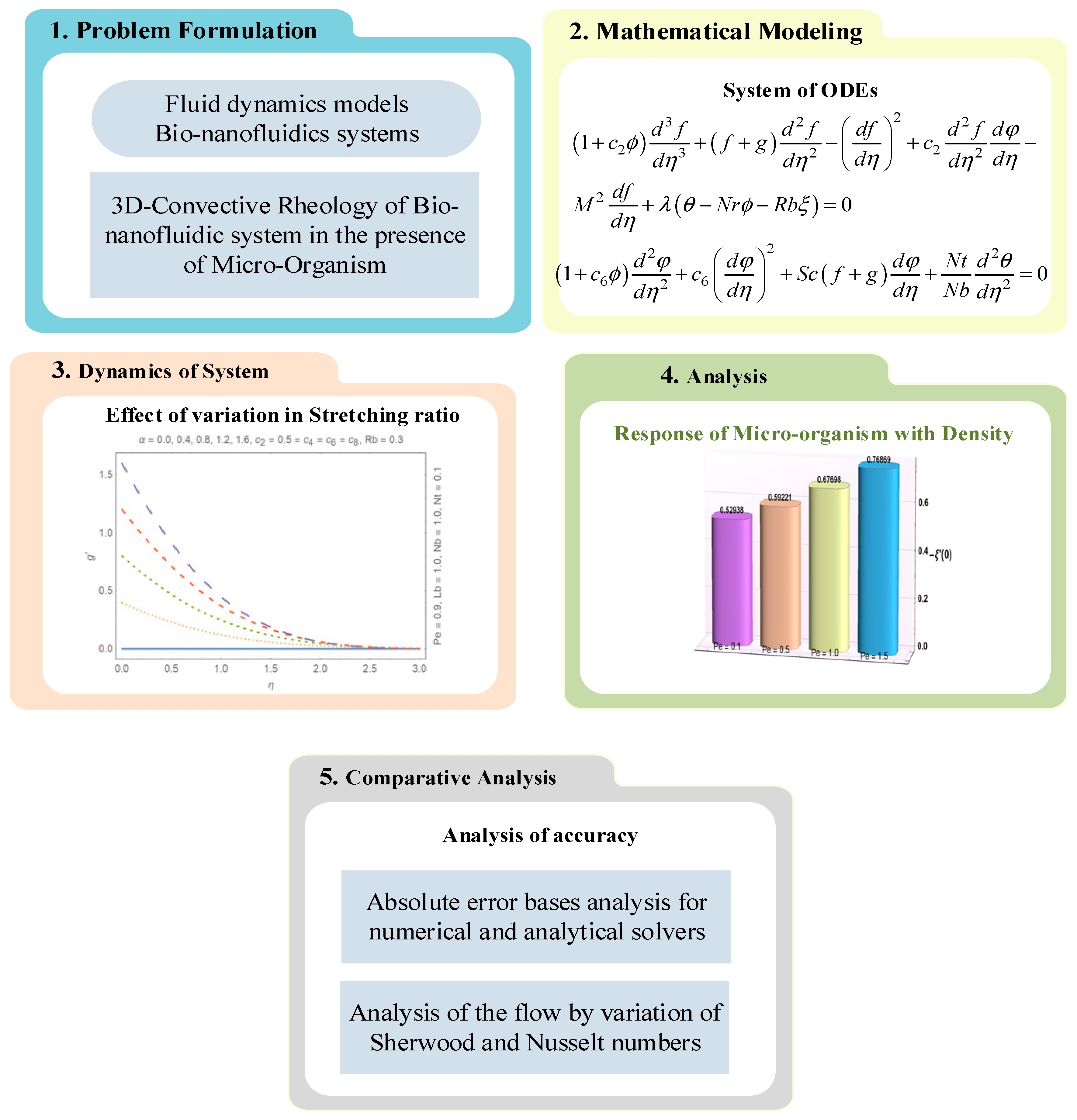
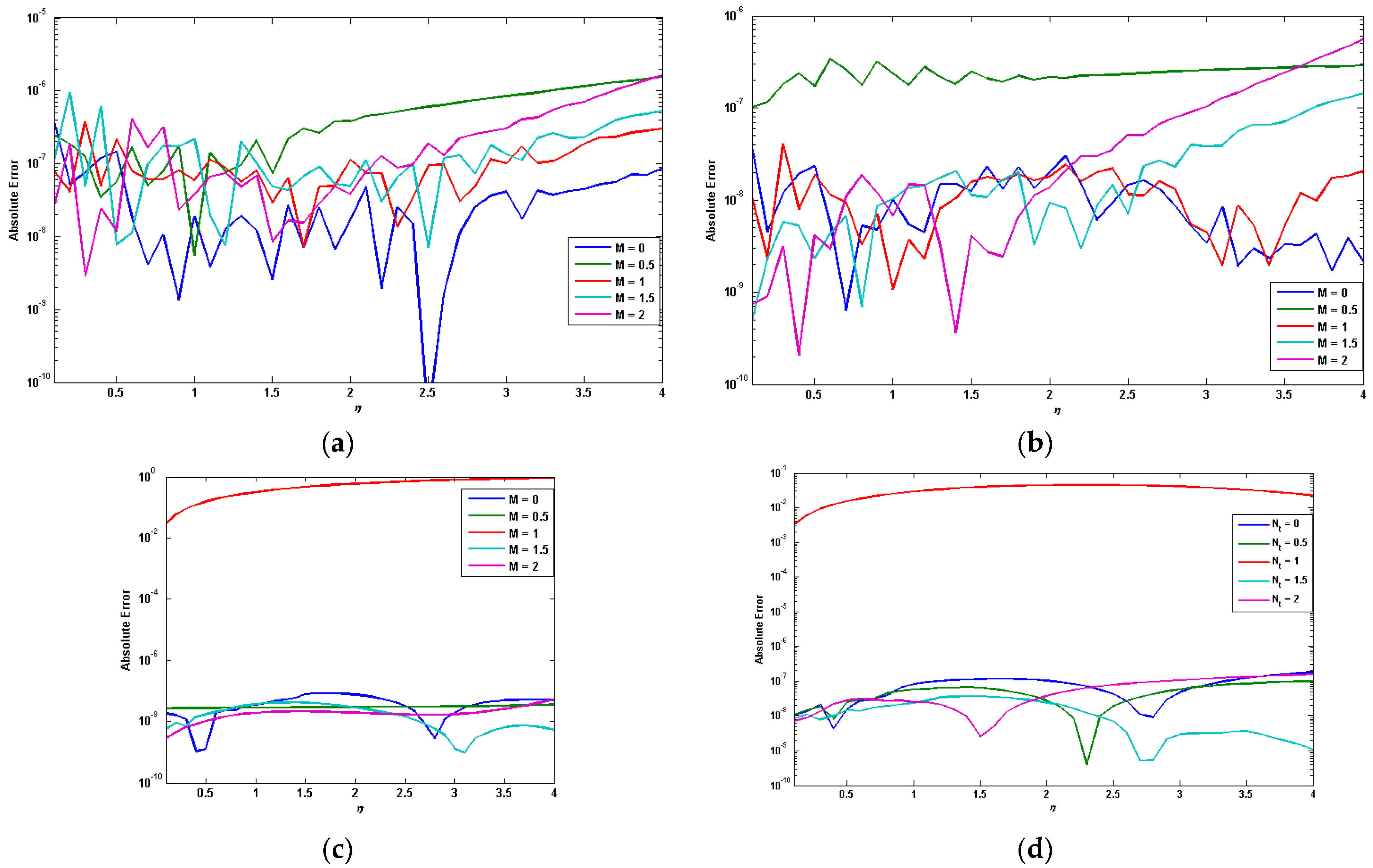
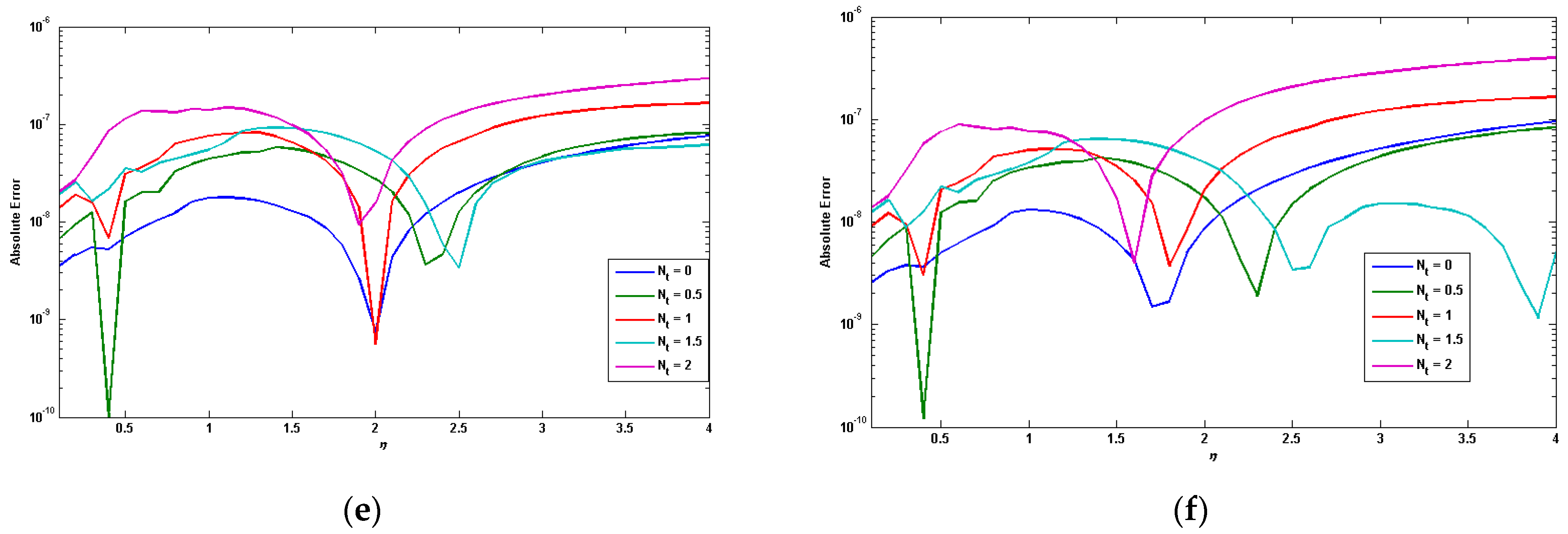
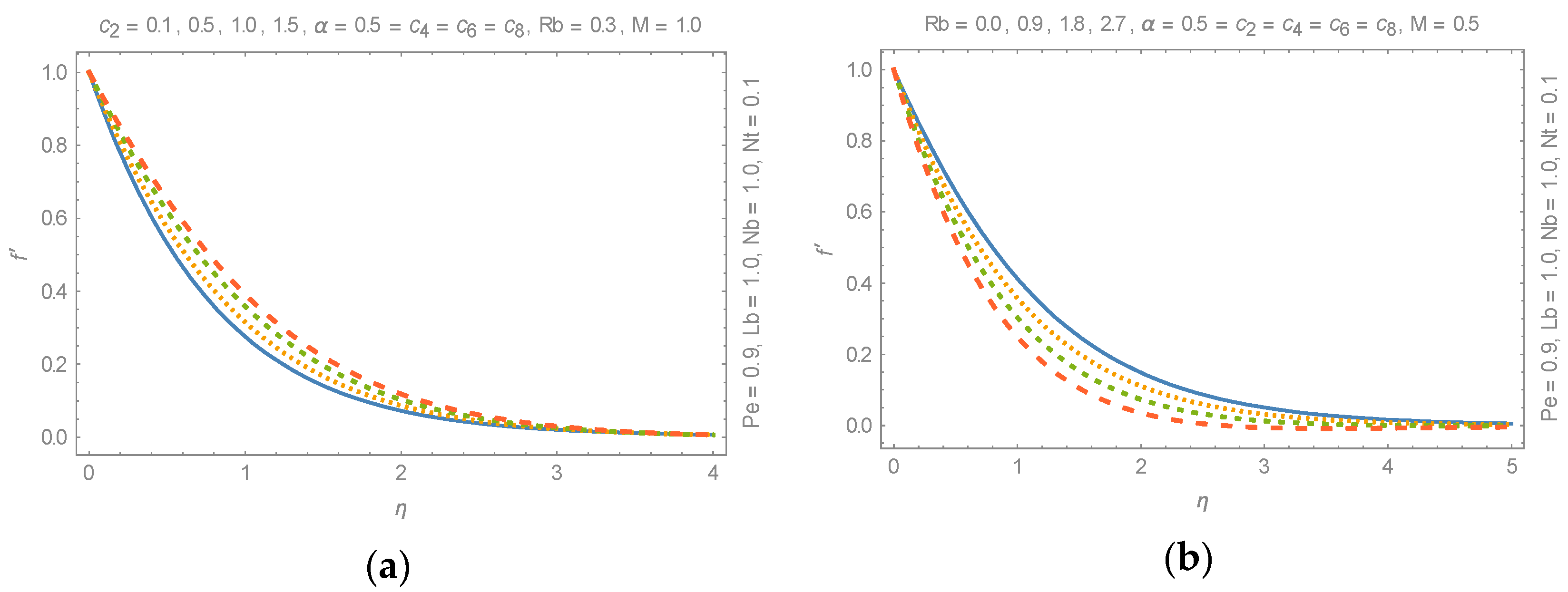
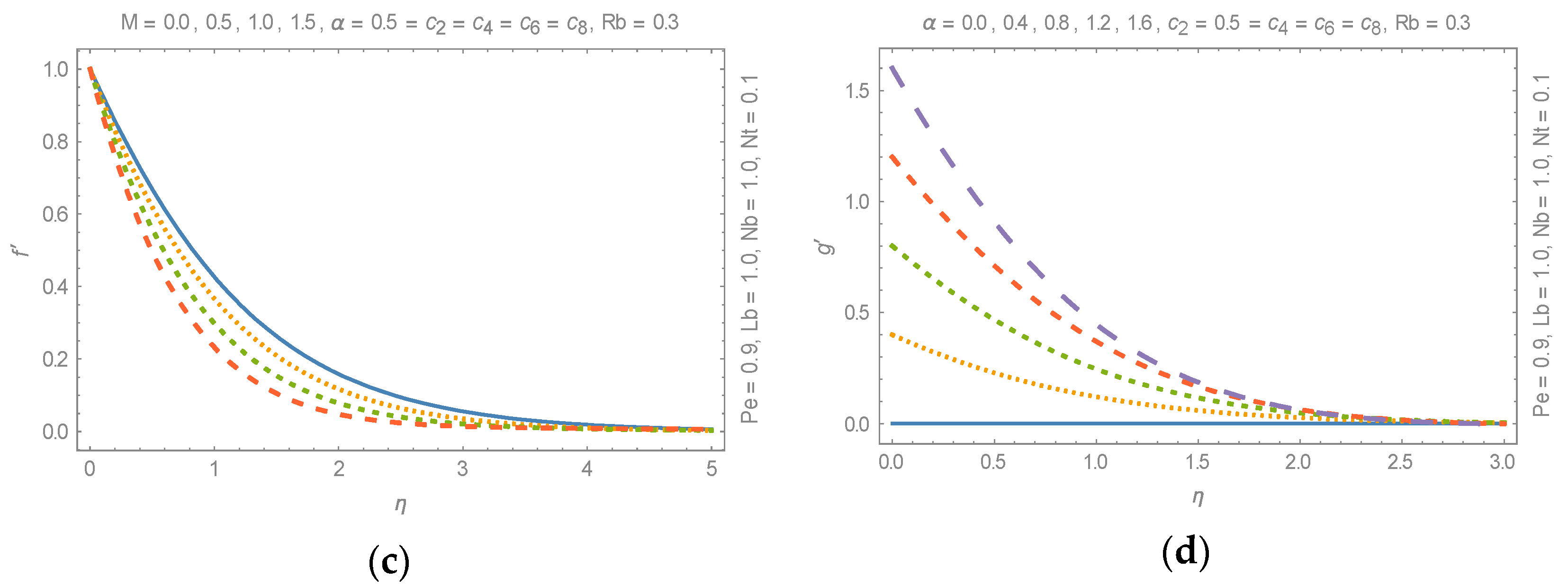
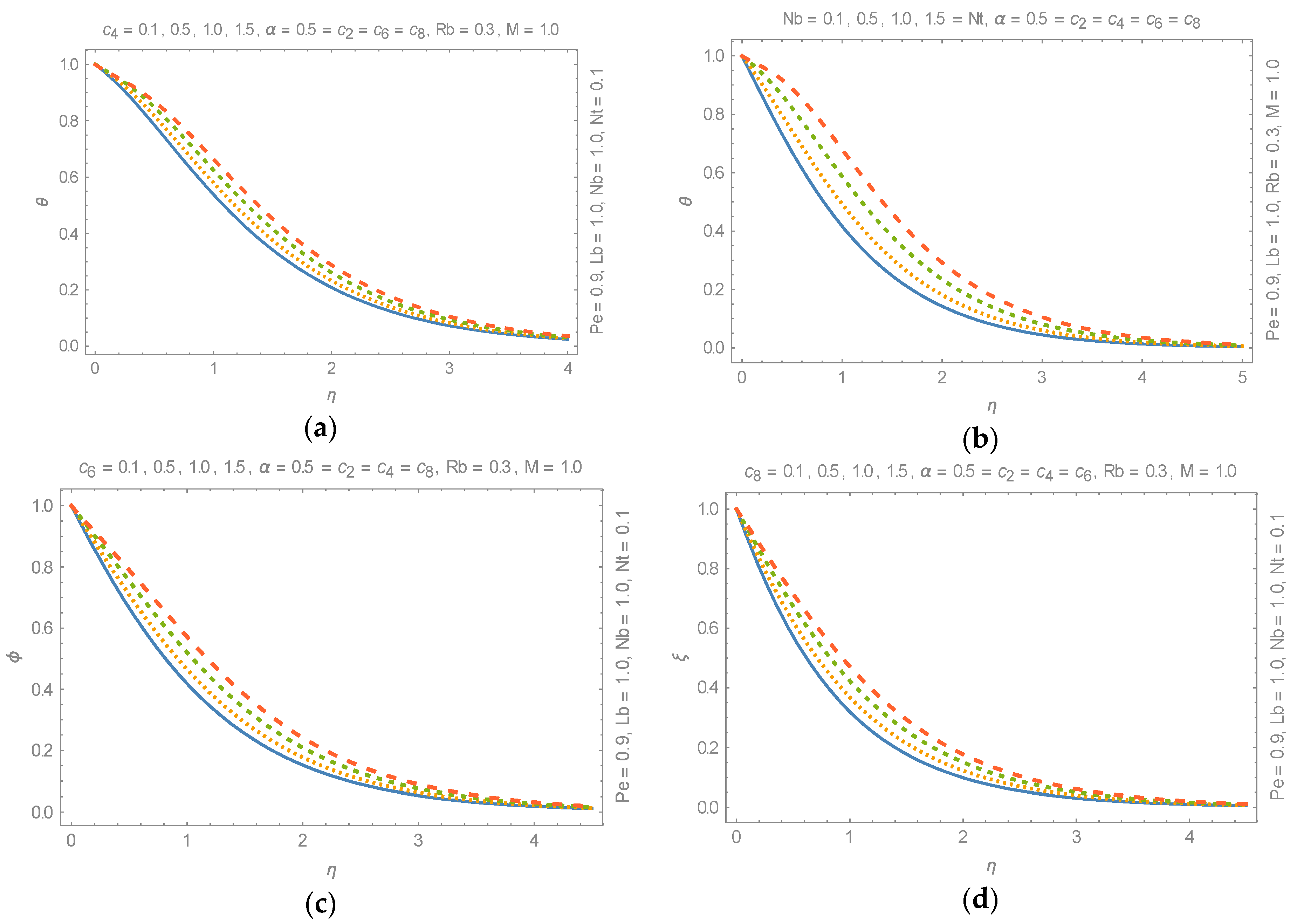
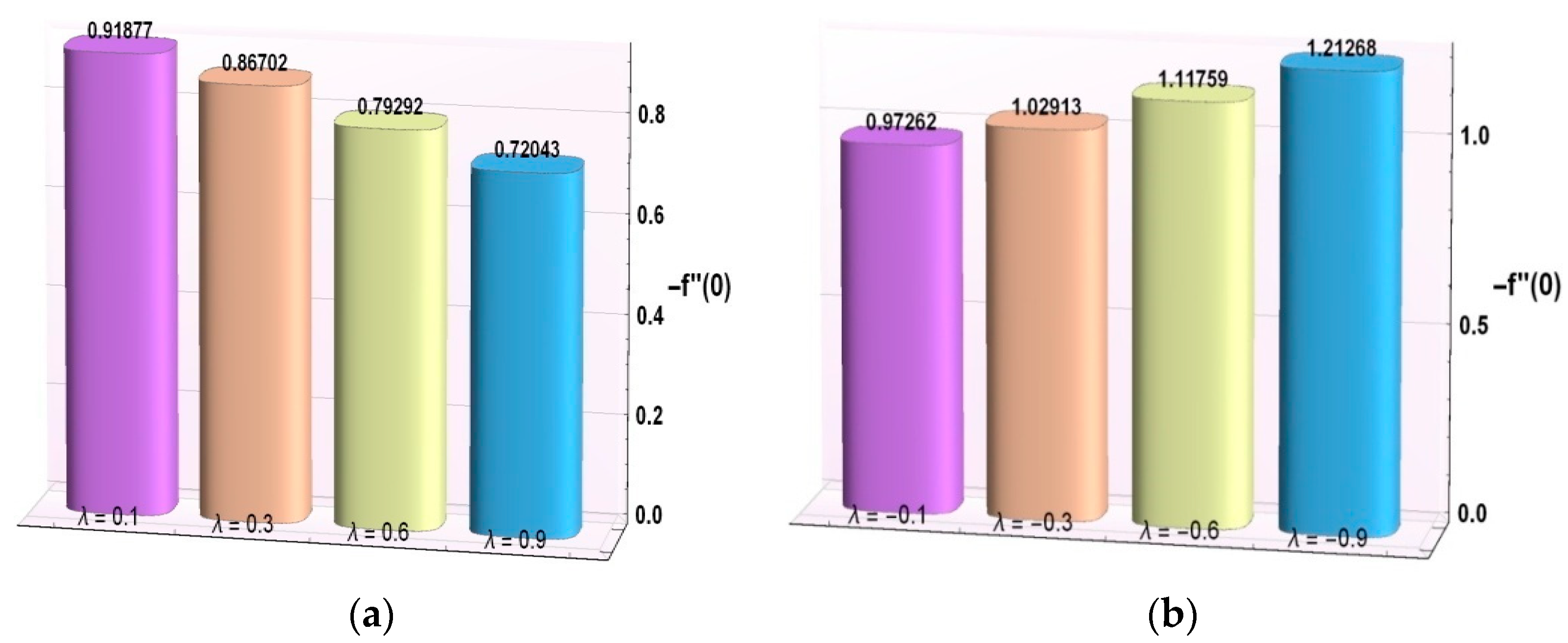
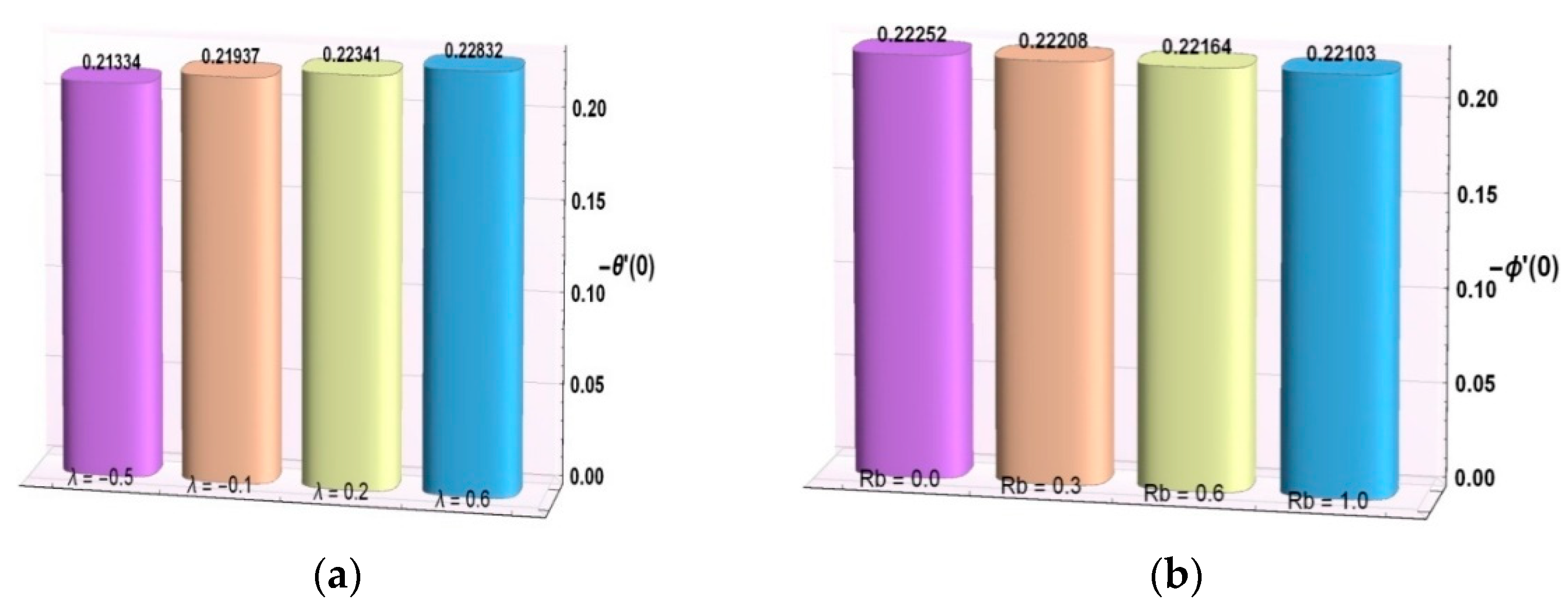

| M | ||||||||||
|---|---|---|---|---|---|---|---|---|---|---|
| 0.0 | 0.5 | 0.5 | 0.3 | 0.1 | 0.5 | 0.1 | 0.5 | |||
| 0.5 | 0.5 | 0.5 | 0.3 | 0.1 | 0.5 | 0.1 | 0.5 | |||
| 1.0 | 0.5 | 0.5 | 0.3 | 0.1 | 0.5 | 0.1 | 0.5 | |||
| 1.5 | 0.5 | 0.5 | 0.3 | 0.1 | 0.5 | 0.1 | 0.5 | |||
| 2.0 | 0.5 | 0.5 | 0.3 | 0.1 | 0.5 | 0.1 | 0.5 | |||
| 1.0 | 0.0 | 0.5 | 0.3 | 0.1 | 0.5 | 0.1 | 0.5 | |||
| 1.0 | 0.3 | 0.5 | 0.3 | 0.1 | 0.5 | 0.1 | 0.5 | |||
| 1.0 | 0.6 | 0.5 | 0.3 | 0.1 | 0.5 | 0.1 | 0.5 | |||
| 1.0 | 1.0 | 0.5 | 0.3 | 0.1 | 0.5 | 0.1 | 0.5 | |||
| 1.0 | 0.5 | 0.3 | 0.3 | 0.1 | 0.5 | 0.1 | 0.5 | |||
| 1.0 | 0.5 | 0.6 | 0.3 | 0.1 | 0.5 | 0.1 | 0.5 | |||
| 1.0 | 0.5 | 1.0 | 0.3 | 0.1 | 0.5 | 0.1 | 0.5 | |||
| 1.0 | 0.5 | 0.5 | 0.0 | 0.1 | 0.5 | 0.1 | 0.5 | |||
| 1.0 | 0.5 | 0.5 | 0.5 | 0.1 | 0.5 | 0.1 | 0.5 | |||
| 1.0 | 0.5 | 0.5 | 1.0 | 0.1 | 0.5 | 0.1 | 0.5 | |||
| 1.0 | 0.5 | 0.5 | 0.3 | 0.0 | 0.5 | 0.1 | 0.5 | |||
| 1.0 | 0.5 | 0.5 | 0.3 | 0.5 | 0.5 | 0.1 | 0.5 | |||
| 1.0 | 0.5 | 0.5 | 0.3 | 1.0 | 0.5 | 0.1 | 0.5 | |||
| 1.0 | 0.5 | 0.5 | 0.3 | 0.1 | 0.0 | 0.1 | 0.5 | |||
| 1.0 | 0.5 | 0.5 | 0.3 | 0.1 | 0.5 | 0.1 | 0.5 | |||
| 1.0 | 0.5 | 0.5 | 0.3 | 0.1 | 1.0 | 0.1 | 0.5 | |||
| 1.0 | 0.5 | 0.5 | 0.3 | 0.1 | 0.5 | 0.0 | 0.5 | |||
| 1.0 | 0.5 | 0.5 | 0.3 | 0.1 | 0.5 | 0.5 | 0.5 | |||
| 1.0 | 0.5 | 0.5 | 0.3 | 0.1 | 0.5 | 1.0 | 0.5 | |||
| 1.0 | 0.5 | 0.5 | 0.3 | 0.1 | 0.5 | 0.1 | 0.0 | |||
| 1.0 | 0.5 | 0.5 | 0.3 | 0.1 | 0.5 | 0.1 | 0.5 | |||
| 1.0 | 0.5 | 0.5 | 0.3 | 0.1 | 0.5 | 0.1 | 1.0 |
| M | |||||||||
| 0.0 | 0.5 | 0.5 | 0.3 | 0.1 | 0.5 | 0.1 | 0.5 | ||
| 0.5 | 0.5 | 0.5 | 0.3 | 0.1 | 0.5 | 0.1 | 0.5 | ||
| 1.0 | 0.5 | 0.5 | 0.3 | 0.1 | 0.5 | 0.1 | 0.5 | ||
| 1.5 | 0.5 | 0.5 | 0.3 | 0.1 | 0.5 | 0.1 | 0.5 | ||
| 2.0 | 0.5 | 0.5 | 0.3 | 0.1 | 0.5 | 0.1 | 0.5 | ||
| 1.0 | 0.0 | 0.5 | 0.3 | 0.1 | 0.5 | 0.1 | 0.5 | ||
| 1.0 | 0.3 | 0.5 | 0.3 | 0.1 | 0.5 | 0.1 | 0.5 | ||
| 1.0 | 0.6 | 0.5 | 0.3 | 0.1 | 0.5 | 0.1 | 0.5 | ||
| 1.0 | 1.0 | 0.5 | 0.3 | 0.1 | 0.5 | 0.1 | 0.5 | ||
| 1.0 | 0.5 | 0.3 | 0.3 | 0.1 | 0.5 | 0.1 | 0.5 | ||
| 1.0 | 0.5 | 0.6 | 0.3 | 0.1 | 0.5 | 0.1 | 0.5 | ||
| 1.0 | 0.5 | 1.0 | 0.3 | 0.1 | 0.5 | 0.1 | 0.5 | ||
| 1.0 | 0.5 | 0.5 | 0.0 | 0.1 | 0.5 | 0.1 | 0.5 | ||
| 1.0 | 0.5 | 0.5 | 0.5 | 0.1 | 0.5 | 0.1 | 0.5 | ||
| 1.0 | 0.5 | 0.5 | 1.0 | 0.1 | 0.5 | 0.1 | 0.5 | ||
| 1.0 | 0.5 | 0.5 | 0.3 | 0.0 | 0.5 | 0.1 | 0.5 | ||
| 1.0 | 0.5 | 0.5 | 0.3 | 0.5 | 0.5 | 0.1 | 0.5 | ||
| 1.0 | 0.5 | 0.5 | 0.3 | 1.0 | 0.5 | 0.1 | 0.5 | ||
| 1.0 | 0.5 | 0.5 | 0.3 | 0.1 | 0.0 | 0.1 | 0.5 | ||
| 1.0 | 0.5 | 0.5 | 0.3 | 0.1 | 0.5 | 0.1 | 0.5 | ||
| 1.0 | 0.5 | 0.5 | 0.3 | 0.1 | 1.0 | 0.1 | 0.5 | ||
| 1.0 | 0.5 | 0.5 | 0.3 | 0.1 | 0.5 | 0.0 | 0.5 | ||
| 1.0 | 0.5 | 0.5 | 0.3 | 0.1 | 0.5 | 0.5 | 0.5 | ||
| 1.0 | 0.5 | 0.5 | 0.3 | 0.1 | 0.5 | 1.0 | 0.5 | ||
| 1.0 | 0.5 | 0.5 | 0.3 | 0.1 | 0.5 | 0.1 | 0.0 | ||
| 1.0 | 0.5 | 0.5 | 0.3 | 0.1 | 0.5 | 0.1 | 0.5 | ||
| 1.0 | 0.5 | 0.5 | 0.3 | 0.1 | 0.5 | 0.1 | 1.0 |
Publisher’s Note: MDPI stays neutral with regard to jurisdictional claims in published maps and institutional affiliations. |
© 2021 by the authors. Licensee MDPI, Basel, Switzerland. This article is an open access article distributed under the terms and conditions of the Creative Commons Attribution (CC BY) license (http://creativecommons.org/licenses/by/4.0/).
Share and Cite
Awais, M.; Ehsan Awan, S.; Asif Zahoor Raja, M.; Parveen, N.; Khan, W.U.; Yousaf Malik, M.; He, Y. Effects of Variable Transport Properties on Heat and Mass Transfer in MHD Bioconvective Nanofluid Rheology with Gyrotactic Microorganisms: Numerical Approach. Coatings 2021, 11, 231. https://doi.org/10.3390/coatings11020231
Awais M, Ehsan Awan S, Asif Zahoor Raja M, Parveen N, Khan WU, Yousaf Malik M, He Y. Effects of Variable Transport Properties on Heat and Mass Transfer in MHD Bioconvective Nanofluid Rheology with Gyrotactic Microorganisms: Numerical Approach. Coatings. 2021; 11(2):231. https://doi.org/10.3390/coatings11020231
Chicago/Turabian StyleAwais, Muhammad, Saeed Ehsan Awan, Muhammad Asif Zahoor Raja, Nabeela Parveen, Wasim Ullah Khan, Muhammad Yousaf Malik, and Yigang He. 2021. "Effects of Variable Transport Properties on Heat and Mass Transfer in MHD Bioconvective Nanofluid Rheology with Gyrotactic Microorganisms: Numerical Approach" Coatings 11, no. 2: 231. https://doi.org/10.3390/coatings11020231
APA StyleAwais, M., Ehsan Awan, S., Asif Zahoor Raja, M., Parveen, N., Khan, W. U., Yousaf Malik, M., & He, Y. (2021). Effects of Variable Transport Properties on Heat and Mass Transfer in MHD Bioconvective Nanofluid Rheology with Gyrotactic Microorganisms: Numerical Approach. Coatings, 11(2), 231. https://doi.org/10.3390/coatings11020231








